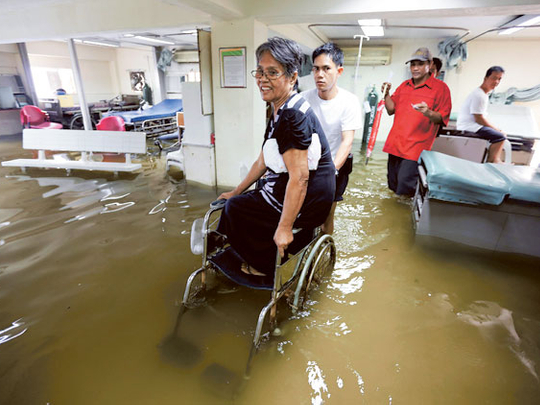
Manila: Four more people were found dead, raising to eight the total number of people who perished as Typhoon Saola, locally known as Gener, slowly crawled away from the sea of northern Luzon, towards Taiwan and China, senior officials said.
Merly Datinginoo drowned in Batangas, southern Luzon; Danieles Hipolito was electrocuted in southern suburban Cavite; Reynante Lingasad Jr drowned in Dipolog City, Zamboanga del Norte; and another unnamed person was buried by a landslide in northern Luzon, said Undersecretary Benito Ramos, head of the National Disaster Risk Reduction and Management Council (NDRRMC).
The list of fatalities in northern Luzon where Typhoon Saolo hit hardest has not yet reached NDRRMC’s Metro Manila office, said Ramos.
Earlier, one death occurred in Antique, central Philippines; two in Laguna, southern Luzon; and one in Metro
Manila’s southern suburban Cavite, areas quite far from northern Luzon where Typhoon Saola remained stationary at sea and did not make a landfall since Saturday, Ramos said, adding that two more were missing in the affected areas.
About 8,298 families or 40,477 people in 14 provinces of Ilocos and Cagayan in northern Luzon, central, and southern Luzon, Metro Manila, central Philippines, and upper part of southern Philippines were affected by Typhoon Saola which poured 25 mm of rain per hour, considered heavy, within a wide diameter of 700 kilometres, Ramos said.
About 2,553 families or 20,496 persons who were hardest hit received government’s relief assistance. Some of them were placed at evacuation centres, and the rest have left their flooded homes and stayed with relatives who stay on safer ground, Ramos said.
Eight bridges remained impassable in northern Luzon’s Baggao, Cagayan, and Isabela; central Philippines’ Aklan; southwestern Philippines Puerto Princesa; and southern Philippines Camiguin, said Ramos.
Ferry services were suspended in the swollen Cagayan River in northern luzon’s Cagayan Province, said Ramos.
Arteries of roads were destroyed in northern Luzon’s Benguet, Vizcaya, Mountain Province, and Ifugao; central Luzon’s Iba, Zambales; southern Luzon’s Batangas, Tubangao, and Lobo; and southwestern Philippines, Busuanga, Palawan.
A dike in central Philippines’ Aklan showed signs of being breached,
In Metro Manila, classes, private and government offices remained closed, flights were diverted for the second time as a combination of low pressure area (LPA) and southwest monsoon also uprooted trees, toppled billboards, and cut off electricity that affected two million of 10 million residents in the metropolis.
Local government units continued the evacuation of residents in coastal and low lying areas as authorities opened the gates of overflowing dams, affecting residents in Metro Manila
Slowly creeping north-northwest at 7 kilometres per hour, with maximum sustained winds of 120 kph near the centre and gusty winds up to 150 kph, Typhoon Saola was predicted to be out of the northern Philippine by Friday, said the Philippine Atmospheric, Geophysical and Astronomical Services Administration (Pagasa).
Satellite photos showed that clouds covered the entire country since Typhoon Saola ravaged the Philippines since Saturday.
About 21 typhoons visit the Philippines every year.











